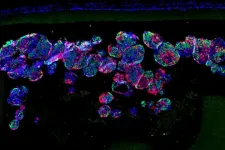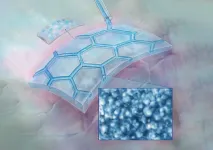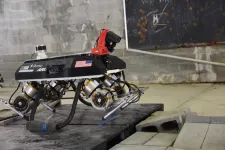Machine learning brings an early diagnostic for pancreatic cancer a step closer to reality
New study demonstrates the possibility of an effective new screening tool for high risk patients
2021-06-02
(Press-News.org) Individuals at higher risk of developing pancreatic cancer could be identified earlier using machine learning (ML) techniques which would result in a greater number of patients surviving the disease, suggests a new study published in PLOS ONE.
The study was led by the London School of Hygiene & Tropical Medicine (LSHTM) and funded by the UK charity Pancreatic Cancer Research Fund (PCRF).
It used UK electronic health records for more than 1,000 patients aged 15-99 years who were diagnosed with pancreatic cancer between January 2005 and June 2009.
The researchers examined numerous symptoms and health statuses recorded by a GP among patients up to two years before the cancer diagnosis. They then developed an algorithm which 'learnt' how to distinguish patients who went on to develop pancreatic cancer from those who didn't.
The algorithm was then used to identify those at high risk of developing pancreatic cancer just from GP records.
Using this technique, 41% of patients under the age of 60 were identified as high risk, up to 20 months prior to diagnosis. Over 72% of people who went on to be diagnosed would have been successfully identified as high risk (sensitivity) whilst 59% of people who did not develop cancer were correctly identified as low risk (specificity). Results were similar for patients over 60, with 43% identified at 17 months, with 65% sensitivity and 57% specificity.
The team estimates that combining their algorithm with simple blood and urine tests which could potentially detect pancreatic cancer, currently under investigation, could result in 30 older and 400 younger patients per cancer being identified as 'potential patients'. This could lead to the earlier diagnosis of around 60% of all pancreatic cancer tumours.
The authors acknowledge that further work is required to confirm, refine and evaluate the potential use of these findings in practice.
Dr Ananya Malhotra, co-lead author from the London School of Hygiene & Tropical Medicine, said: "Each year, 460,000 people worldwide are diagnosed with pancreatic cancer, and only around 5% of those diagnosed survive for five years or more. This low survival is because patients are usually diagnosed very late. Recent progress has been made in identifying biomarkers in the blood and urine, but these tests cannot be used for population screening as they would be very expensive and potentially harmful due to the psychological distress of excess testing.
"Although preliminary, this study offers some hope for a new early diagnosis for pancreatic cancer which until now remains elusive."
Previous research has highlighted conditions associated with pancreatic cancer diagnosis such as jaundice, abdominal pain and new-onset diabetes. Whilst these new results are consistent with these findings, this approach is a step-change from these previous studies because the team examined whether it is possible to predict future pancreatic cancer based on the presence of a combination of symptoms or abnormalities more than 12 months before diagnosis, ignoring late-stage symptoms.
The case-control study used anonymised electronic health records from primary care linked to cancer registrations. Cases were comprised of 1,139 patients, aged 15-99 years, diagnosed with pancreatic cancer between January 2005 and June 2009. Each case was age-, sex- and diagnosis time-matched to four non-pancreatic (cancer patient) controls. Disease and prescription codes for the 24 months prior to diagnosis were used to identify 57 individual symptoms, with models then trained to predict patients who later developed pancreatic cancer.
The algorithm's greatest potential is within a multiple-testing model where pancreatic cancer is one of several malignancies of interest. Another important finding was the relative importance of diabetes, over time-varying symptoms, in predicting later pancreatic cancer diagnosis, which is consistent with previous research.
Dr Laura Woods, study senior author from the London School of Hygiene & Tropical Medicine, said: "Using machine learning techniques we developed a risk score for pancreatic cancer diagnosis in order to identify patients for whom biomarkers might detect the disease at an early and treatable stage. After further work this approach could be applied in the primary care setting and has the potential to be used alongside a non-invasive biomarker test to increase earlier diagnosis. This would result in a greater number of patients surviving this devastating disease."
Maggie Blanks, Pancreatic Cancer Research Fund's Chief Executive Officer, said: "Using machine learning to help improve earlier diagnosis is truly novel and we're extremely pleased that this pilot study has shown to have strong potential. We're looking forward to seeing where this research leads, as earlier diagnosis will be a game-changer for improving survival for patients."
The authors acknowledge limitations of the study including the poor specificity of the models arising principally from the use of cancer patients as controls that are not representative of the general population.
The research team is seeking further funding to develop this pilot study into a full investigation.
INFORMATION:
ELSE PRESS RELEASES FROM THIS DATE:
2021-06-02
A team of researchers led by diabetes specialists and biomedical engineers at Washington University School of Medicine in St. Louis and Cornell University has demonstrated that, using a miniscule device, they can implant insulin-secreting cells into diabetic mice. Once implanted, the cells secrete insulin in response to blood sugar, reversing diabetes without requiring drugs to suppress the immune system.
The findings are published June 2 in the journal Science Translational Medicine.
"We can take a person's skin or fat cells, make them into stem cells and then grow those stem cells into insulin-secreting cells," said Jeffrey R. Millman, PhD, an associate professor of medicine at Washington ...
2021-06-02
A new study reveals that B cells can produce antibodies against the H1N1 influenza virus that also neutralize various other influenza strains, marking a development that could inform research into potential universal flu vaccines. The findings showed that the antibodies targeted two conserved regions of the virus - the cause of the 2009 swine flu pandemic - and that transfers of the antibodies protected mice from lethal infection. The work suggests that vaccines that target the two sites might be able to protect against a broader array of flu strains. Influenza is one of humanity's greatest microbial ...
2021-06-02
RICHLAND, Wash.--Scientists have created a cybersecurity technology called Shadow Figment that is designed to lure hackers into an artificial world, then stop them from doing damage by feeding them illusory tidbits of success.
The aim is to sequester bad actors by captivating them with an attractive--but imaginary--world.
The technology is aimed at protecting physical targets--infrastructure such as buildings, the electric grid, water and sewage systems, and even pipelines. The technology was developed by scientists at the U.S. Department of Energy's Pacific Northwest National Laboratory.
The starting point for Shadow Figment is an oft-deployed technology called a honeypot--something attractive to lure an attacker, perhaps a desirable target with the appearance of easy access.
But ...
2021-06-02
A new study from North Carolina State University found that certain types of messages could influence how people perceive information about the spread of diseases from wildlife to humans.
The researchers say the findings, published in the journal Frontiers in Communication, could help scientists, policymakers and others more effectively communicate with diverse audiences about zoonotic diseases and the role of wildlife management in preventing them from spreading to people. Zoonotic diseases are diseases that originate in wildlife and become infectious to people.
"If we want to prevent ...
2021-06-02
A new global review has found that receiving Opioid Agonist Therapy (OAT) is associated with lower risk of multiple causes of death among people with opioid dependence.
The review found that people with opioid dependence were less likely to experience overdose-related, suicide, alcohol-related, cancer, and cardiovascular-related mortality while receiving OAT.
Researchers from the National Drug and Alcohol Research Centre (NDARC) at UNSW Sydney, University of Bristol and several other global institutions reviewed the relationship between OAT and mortality across type of drug, setting and participant groups from over 700,000 participants, which is six times the number of any other previous review.
The review found that mortality risk ...
2021-06-02
Spiders avoid building webs near European fire ants, their natural predators, by sensing the chemicals they give off in the environment, Simon Fraser University researchers have found.
The findings, published recently in Royal Society Open Science, give us a peek inside the enduring struggle between spiders and ants, and could lead to the development of natural repellents for homeowners worried about unwanted eight-legged guests.
Many ants prey on spiders, suggesting that web-building spiders may avoid locations near ant colonies or frequented by foraging ...
2021-06-02
The future of electronic displays will be thin, flexible and durable. One barrier to this, however, is that one of the most widely used transparent conductors for electronic displays--indium tin oxide (ITO)--doesn't perform as well on larger areas and can crack and break down with wear. Indium is also a rare earth mineral, which is relatively scarce, and the process to create ITO requires high energy consumption and expensive equipment.
One emerging alternative is metal "microgrid" conductors. These microgrids can be customized to their application by varying the microgrid width, pitch and thickness, and they can be made with a variety of metals.
New research from the University of Pittsburgh Swanson School of Engineering ...
2021-06-02
Researchers have demonstrated "giant flexoelectricity" in soft elastomers that could improve robot movement range and make self-powered pacemakers a real possibility. In a paper published this month in the Proceedings of the National Academy of Sciences, scientists from the University of Houston and Air Force Research Laboratory explain how to engineer ostensibly ordinary substances like silicone rubber into an electric powerhouse.
What do the following have in common: a self-powered implanted medical device, a soft human-like robot and how we hear sound? The answer as to why these two disparate technologies and biological phenomena ...
2021-06-02
SMU Office of Research & Tech Transfer - Whether they are in the technology or oil sector, selling shoes or healthcare products, for many companies, green is the new black. While maximising profit might have been the sole priority for most businesses a decade ago, these days it is common for mission-oriented companies to pursue the 'triple bottom line' of people, planet and profit, particularly through corporate social responsibility (CSR) efforts.
While such efforts are commendable, some investors remain primarily concerned about whether firms can do well by doing good; in other words, whether CSR actually can increase a company's value. For instance, CSR activities could enhance brand image and improve customer loyalty, or even make it easier to attract and retain talent, leading to ...
2021-06-02
ABERDEEN PROVING GROUND, Md. - A new formula from Army scientists is leading to new insights on how to build an energy-efficient legged teammate for dismounted warfighters.
In a recent peer-reviewed PLOS One paper, the U.S. Army Combat Capabilities Development Command, known as DEVCOM, Army Research Laboratory's Drs. Alexander Kott, Sean Gart and Jason Pusey offer new insights on building autonomous military robotic legged platforms to operate as efficiently as any other ground mobile systems.
Its use could lead to potentially important changes to Army vehicle development. Scientists said they may not know exactly why legged, wheeled and tracked ...
LAST 30 PRESS RELEASES:
[Press-News.org] Machine learning brings an early diagnostic for pancreatic cancer a step closer to reality
New study demonstrates the possibility of an effective new screening tool for high risk patients




